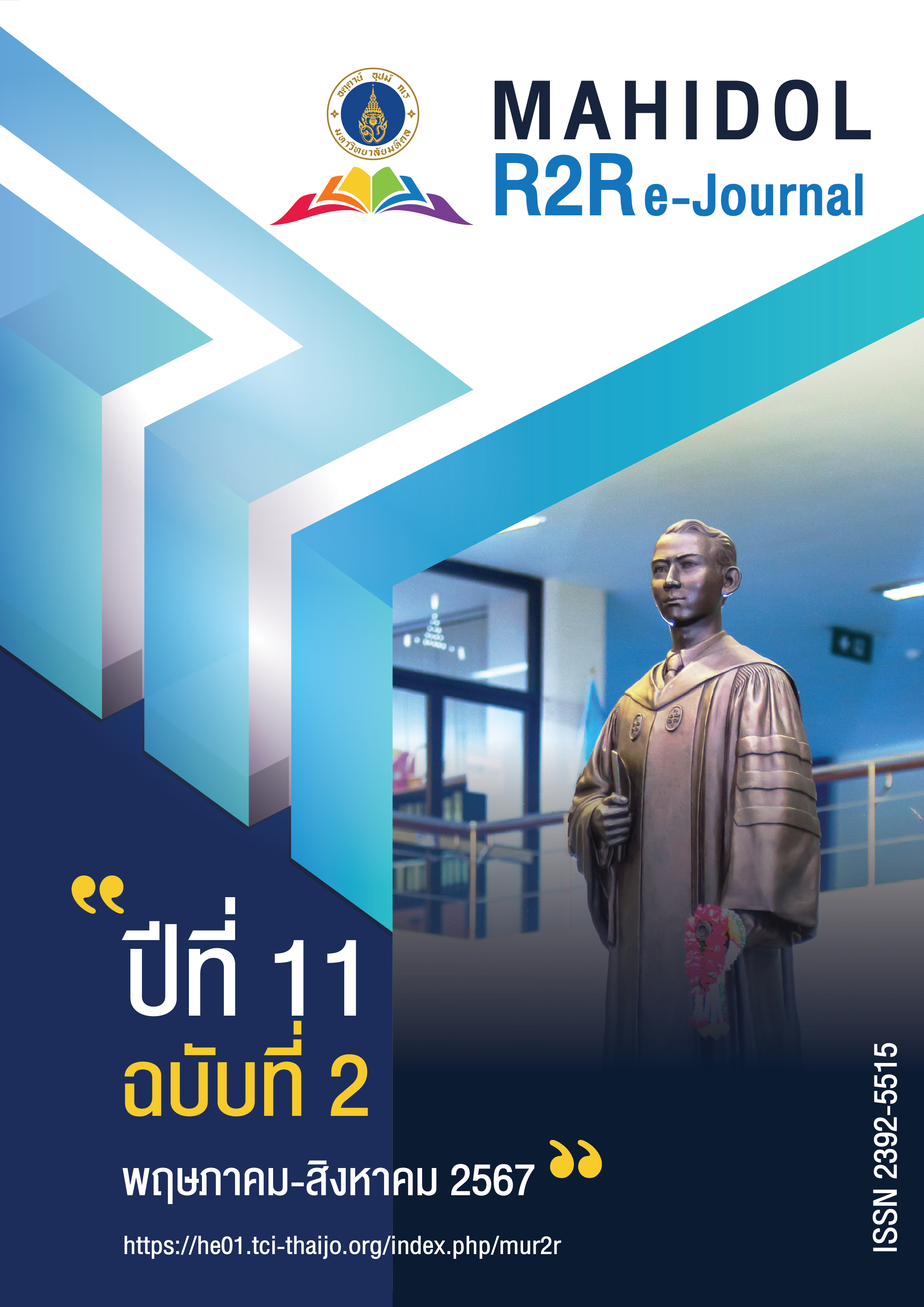A Comparison Study of Organizational Information Security Culture between Personnel within and outside the Scope of Information Security Management System, Golden Jubilee Medical Center, Faculty of Medicine Siriraj Hospital
DOI:
https://doi.org/10.14456/jmu.2024.19Keywords:
Organizational culture, Information SecurityAbstract
The objectives of this research were: 1) to study the information security culture of Golden Jubilee Medical Center, 2) to examine the information security culture as it relates to personal factors and departments within and outside the scope of the information security management system at Golden Jubilee Medical Center. The sample was randomly selected using stratified random sampling, and it was grouped by departments within and outside the scope of the information security management system. The study instrument used was a questionnaire. Data were collected and analyzed using percentages, means, standard deviations, and statistical tests performed using SPSS.
The results showed that the personnel of Golden Jubilee Medical Center have an information security culture that meets the criteria. However, when comparing personnel within the scope of the information security management system with those outside the scope, the statistics showed no significant difference (p > .05)
References
เมธาพร ธรรมสิริ และ ศิริภัสสรศ์ วงศ์ทองดี. (2565). ความตระหนักรู้ด้านภัยคุกคามไซเบอร์ของบุคลากรในบริษัทเอกชนแห่งหนึ่งในเขตกรุงเทพมหานคร. วารสารวิชาการไทยและการจัดการ. 3(2), 1-17
อภิญญา รัตนาตรานุรักษ์. (2561). ปัจจัยที่ส่งเสริมให้พนักงานในองค์กรแสดงออกถึงพฤติกรรมในการปฏิบัติตามนโยบายการรักษาความมั่นคงปลอดภัยสารสนเทศ. วารสารระบบสารสนเทศด้านธุรกิจ (JISB). 4(3), 40-65.
AlHogail, A. & Mirza, A. (2014, October 1). Information security culture: A definition and a literature review. 2014 World Congress on Computer Applications and Information Systems (WCCAIS), pp. 1-7. DOI: 10.1109/WCCAIS.2014.6916579.
Bulgurcu, B., Cavusoglu, H., & Benbasat, I. (2010). Information Security Policy Compliance: An empirical study of rationality-based beliefs and information security awareness. MIS Quarterly, 34(3), 523-548.
Da Veiga, A., & Martins, N. (2015). Information security culture and information protection culture: A validated assessment instrument. Computer Law & Security Review, 31(2), 243-256. doi: 10.1016/j.clsr.2015.01.005
Ifinedo, P. (2012). Understanding Information Systems Security Policy Compliance: An Integration of the Theory of Planned Behavior and the Protection Motivation Theory. Computers & Security, 31, 83-95. https://doi.org/10.1016/j.cose.2011.10.007
Ngo, L., Zhou, W., & Warren, M. (2005). Understanding transition towards information security culture change. In Proceedings of 3rd Australian Information Security Management Conference, pp. 67-73. https://ro.ecu.edu.au/ecuworks/7317/
Sas, M., Hardyns, W., van Nunen, K., Reniers, G., & Ponnet, K. (2020). Measuring the security culture in organizations: a systematic overview of existing tools. Security Journal, 34(2), 340-357. https://doi.org/10.1057/s41284-020-00228-4
Schlienger, T. & Teufel, S., (2003, September 1-5). Analyzing information security culture: increased trust by an appropriate information security culture, 14th International Workshop on Database and Expert Systems Applications, 2003. Proceedings, pp. 405-409. DOI: 10.1109/DEXA.2003.1232055
Shropshire, J., Warkentin, M., & Sharma, S. (2015). Personality, attitudes, and intentions: Predicting initial adoption of information security behavior. Computer and Security, 49, 177-191.
Vance, A., Lowry, P. B., & Eggett, D. (2015). A new approach to the problem of access policy violations: Increasing perceptions of accountability through the user interface, MIS Quarterly, 39(2), 345-366
Downloads
Published
Issue
Section
License
Copyright (c) 2024 Mahidol R2R e-Journal

This work is licensed under a Creative Commons Attribution-NonCommercial-NoDerivatives 4.0 International License.
ข้อความลิขสิทธิ์ (Copyright text)
บทความที่ได้รับการตีพิมพ์เป็นลิขสิทธิ์ของวารสาร Mahidol R2R e-Journal กองทรัพยากรบุคคล มหาวิทยาลัยมหิดล อนุญาตให้นำข้อความ เนื้อหา รูปภาพ ไปพิมพ์เผยแพร่ได้ แต่ห้ามนำไปใช้ประโยชน์ในเชิงพาณิชย์ หรือมีเจตนาเอื้อผลประโยชน์ในทางธุรกิจใดๆ
ข้อความที่ปรากฏในบทความแต่ละเรื่องในวารสารวิชาการเล่มนี้เป็นความคิดเห็นส่วนตัวของผู้เขียนแต่ละท่าน ความรับผิดชอบ องค์ประกอบทั้งหมดของบทความแต่ละเรื่องเป็นของผู้เขียนแต่ละท่าน หากมีความผิดพลาดใด ๆ ผู้เขียนแต่ละท่านจะรับผิดชอบบทความของตนเองแต่ผู้เดียว
ผลประโยชน์ทับซ้อน (Conflicts of Interest)
ผู้ประพันธ์ต้องเปิดเผยเป็นลายลักษณ์อักษร (ระบุในรายงาน)ถึงทุกปัจจัยรวมทั้งปัจจัยด้านการเงินที่อาจมีอิทธิผลต่อ การศึกษาผลการศึกษาหรือข้อสรุปจากรายงานการศึกษาวิจัย และจำเป็นต้องระบุหากได้รับการสนับสนุนทางการเงินจาก แหล่งทุนภายนอกเพื่อให้สอดคล้องกับคำประกาศของบรรณาธิการ ผู้ร่วมประพันธ์ทุกท่านต้องมีส่วนร่วมในผลงานการศึกษาวิจัย และควรมีการระบุไว้อย่างชัดเจนในหนังสือปะหน้าประกอบการส่งเรื่องที่จะตีพิมพ์ รวมทั้งระบุไว้ในส่วนของกิตติกรรมประกาศ (acknowledgements) ในตอนท้ายของรายงานต้นฉบับ



